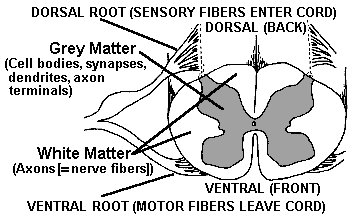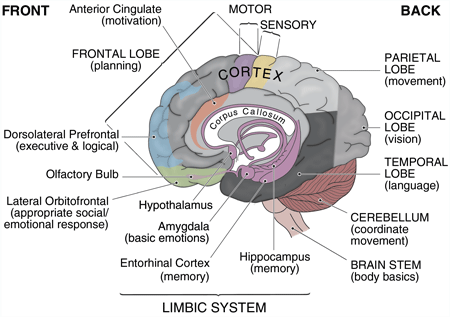NERVOUS SYSTEM
NERVOUS SYSTEM
CENTRAL
SPINAL CORD
BRAIN
PERIPHERAL
MOTOR
SENSORY
Central Nervous System (CNS)
- FUNCTION: Transmission and Processing
- Stores memories, thought process, receives signals and appreciates responses
SPINAL CORD
- Located inside the backbone
- Entire nervous system
-
Grey Matter: Head of neurons (cell body)
-
White Matter: Axon/extended arms
- Spinal cord is the link between the central nervous system and the peripheral nervous system
- If damaged, paralysis
BRAIN
Fore Brain
-
Processes signals
-
Stores memories
-
Creates thoughts
Mid Brain
-
Coordinates signals
-
Reactions between PNS and CNS
Hind Brain
-
Heart beat, respiration, breathing
-
Most basic functions


Figure 1. Spinal Cord Anatomy
Figure 2. Brain
Peripheral Nervous System (PNS)
- Nerves, neurons, sensory organs OUTSIDE the spinal cord
- Takes signals and transmits to the CNS

Types of Neurons:
1. Sensory
2. Association -Present in the brain
3. Motor - Very long transmission lines
4. Effectors - Receive signals from brain, carries out effect
STRUCTURE OF A NEURON
Cell body - Contains nucleus, cytoplasm, cell surface membrane and organelles. Irregular in shape
Dendron - The nerve fibres that transmit nerve impulses towards the cell body. The end branches of dendrons are called dendrites.
Axon - The nerve fibres that transmit nerve impulses away from the cell body; usually long.
Myelin Sheath - The layer of fatty substances enclosing many nerve fibres (like a rubber sheath for insulation of an electricity-conducting wire)
Nodes of Ranvier - The regions where the myelin sheath is absent
Axon Terminals - Transmit nerve impulses to the effector
Figure 3. Diagram of a neuron

Figure 4. Reflex Arc
THE REFLEX ARC
- Feel something, responded, but brain did not process
- All neurons involved except accessory
-Impulses from point of pain to spinal cord to effectors
BASIC OPERATIONS OF THE NERVOUS SYSTEM
1. Determine type of stimulus
2. Signal intensity of stimulus
3. Integrate response from many sources
4. Initiate and direct responses
The Brain

Why do we need a brain?
- Use memory and process stimulus to regulate body
- Appropriate movement critical for survival
Parts of the Brain
HIND BRAIN
1. Medulla - Controls autonomic functions
2. Pans - Controls sleep stages
3. Cerebellum - Coordinates movement, stores some motor memory (muscle memory)
MID BRAIN
1. Reticular formation - 'traffic cops' of brain
2. Filters sensory input allowing concentration
3. Filtering can be affected by higher thought
FORE BRAIN
1. Thalamus - Relay station (channeling sensory information
2. Limbic system - Basic emotions, drives and behaviors
3. Pituitary Gland - Secretes hormones
4. Cortex - Higher thought
CORTEX
- Thought and emotion
- Sensory processes
- Motor control
- Wiring is plastic: Specialization can change, e.g. blind person has better hearing
LEFT BRAIN - Right Body (Practical Numericals)
RIGHT BRAIN - Left Body (Creativity)
MEMORY
Long term - 'Working memory', distinct things you remember
Short term - Remembered for only a few days
SENSORY RECEPTORS
Photoreception - Sight, pupils
Chemoreception - Taste, pain
Mechanoreception - Hearing, sound waves from environment to cochlea
Thermoreception - Touch, cold and hot things, direct from PNS
Figure 5. Diagram of brain

Hearing
1. Ear gathers sound waves
2. Inner ear bone amplifies sound
3. Sound transmitted to cochlea
4. Hair cells on basilar membrane vibrate certain frequencies and send signals to auditroy nerve
5. Loud sounds can damage these hairs permanently
Figure 6. Diagram of ear

Sight
1. Light enters eye through cornea and pupil
2. Light focuses by convex lens
3. Light strikes retina and stimulates receptors
SYNTHESIA
- Cross sensory perceptions
- Experiencing flashes of particular colors or textures when hearing sound.
Figure 7. Diagram of eye